Themed collection Ionic Liquids in the Synthesis, Fabrication, and Utilization of Materials and Devices

Is it possible to control kinetic rates of radical polymerisation in ionic liquids?
This work predicted propagation rates of free radical polymerisation in clusters of ionic liquids: stabilisation of the propagating radical and deactivation of the monomer were found to be the main factors in controlling kinetic rates, allowing for controlled free radical polymerisation in ionic liquids.

Chem. Commun., 2018,54, 11226-11243
https://doi.org/10.1039/C8CC02012D
Making good on a promise: ionic liquids with genuinely high degrees of thermal stability
Most ionic liquids are not, as frequently asserted, materials of unusual thermal stability. However, it is possible to create ionic liquids which are, through a combination of iterative ion design/synthesis, and thermochemical measurements, coupled with quantum and molecular dynamics calculations.
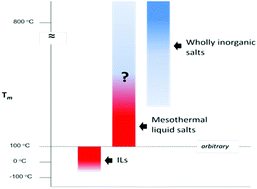
Chem. Commun., 2018,54, 5019-5031
https://doi.org/10.1039/C8CC01716F
Variations and applications of the oxygen reduction reaction in ionic liquids
Increasing energy demands call for new energy storage technologies with high energy density to meet current and future needs.

Chem. Commun., 2018,54, 3800-3810
https://doi.org/10.1039/C8CC00595H
Ionic liquid syntheses via click chemistry: expeditious routes toward versatile functional materials
The application of click reaction (e.g. CuAAC, thiol–X, oxime formation and nucleophilic ring opening) has recently begun to draw attention for efficient and robust synthesis of new functional ionic liquids, requiring minimal purification.
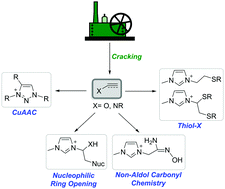
Chem. Commun., 2018,54, 2944-2961
https://doi.org/10.1039/C8CC00372F
The impact of sulfur functionalisation on nitrogen-based ionic liquid cations
XPS is used to investigate the impact of sulfur containing substituents on the electronic structure of a series of N-based cations, all with a common anion, [NTf2]−. The experimental data is complex and cannot be easily deconstructed, DFT provides critical insight into bonding and electronic structure for each system studied.
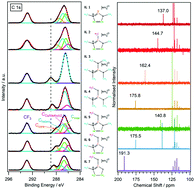
Chem. Commun., 2018,54, 11403-11406
https://doi.org/10.1039/C8CC05515G
Frustrated Lewis pairs in ionic liquids and molecular solvents – a neutron scattering and NMR study of encounter complexes
Encounter complexes of a frustrated lewis pair are more stable and prevalent in an ionic liquid than in benzene.
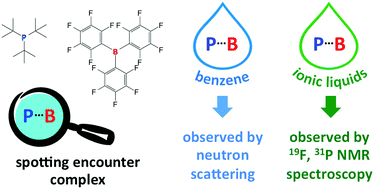
Chem. Commun., 2018,54, 8689-8692
https://doi.org/10.1039/C8CC03794A
Au–Pd bimetallic nanoparticles supported on a high nitrogen-rich ordered mesoporous carbon as an efficient catalyst for room temperature Ullmann coupling of aryl chlorides in aqueous media
An ionic liquid derived highly nitrogen-rich mesoporous carbon supported Au–Pd alloy was found to be an efficient and recyclable catalyst for the Ullmann coupling reaction of various aryl chlorides at room temperature.

Chem. Commun., 2018,54, 7155-7158
https://doi.org/10.1039/C8CC00475G
Piperidinium ionic liquids as electrolyte solvents for sustained high temperature supercapacitor operation
A supercapacitor with a piperidinium ionic liquid and an LiTFSI electrolyte operates for 10 000+ cycles at 100 °C.
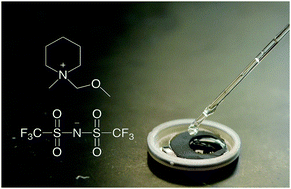
Chem. Commun., 2018,54, 5590-5593
https://doi.org/10.1039/C8CC01093E
Towards thermally stable high performance lithium-ion batteries: the combination of a phosphonium cation ionic liquid and a 3D porous molybdenum disulfide/graphene electrode
A lithium battery with excellent performance and thermal stability is realized by using a nanostructured electrode and an ionic liquid.
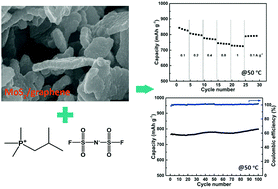
Chem. Commun., 2018,54, 5338-5341
https://doi.org/10.1039/C8CC01460D
Relevance of ion clusters for Li transport at elevated salt concentrations in [Pyr12O1][FTFSI] ionic liquid-based electrolytes
Li ion transport in ionic liquid is dominated by vehicular transport in net negatively charged clusters even at enhanced salt concentration.
![Graphical abstract: Relevance of ion clusters for Li transport at elevated salt concentrations in [Pyr12O1][FTFSI] ionic liquid-based electrolytes](/en/Image/Get?imageInfo.ImageType=GA&imageInfo.ImageIdentifier.ManuscriptID=C8CC01416G&imageInfo.ImageIdentifier.Year=2018)
Chem. Commun., 2018,54, 4278-4281
https://doi.org/10.1039/C8CC01416G
Rechargeable aluminum batteries utilizing a chloroaluminate inorganic ionic liquid electrolyte
A chloroaluminate inorganic ionic liquid electrolyte can boost the electrochemical activity of a graphitic carbon cathode for rechargeable Al batteries.
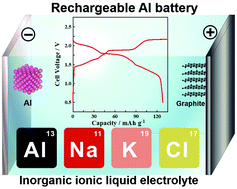
Chem. Commun., 2018,54, 4164-4167
https://doi.org/10.1039/C8CC00113H
A symmetrical ionic liquid/Li salt system for rapid ion transport and stable lithium electrochemistry
A concentrated lithium salt electrolyte utilising the diethylpyrrolidinium cation and bis(fluorosulfonyl)imide anion shows high ionic conductivity and good Li electrochemistry.

Chem. Commun., 2018,54, 3660-3663
https://doi.org/10.1039/C8CC00531A
Design of task-specific fluorinated ionic liquids: nanosegregation versus hydrogen-bonding ability in aqueous solutions
Fluorinated ionic liquids rich-nanosegregated behaviour reduces the impact of the addition of water upon the ionic liquids's H-bond acceptance ability.
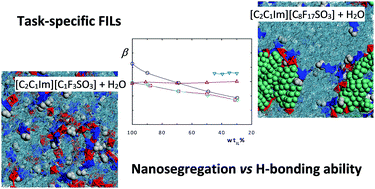
Chem. Commun., 2018,54, 3524-3527
https://doi.org/10.1039/C8CC00361K
Ionic liquid electrolytes supporting high energy density in sodium-ion batteries based on sodium vanadium phosphate composites
Sodium ion batteries (SIBs) are widely considered as alternative, sustainable, and cost-effective energy storage devices for large-scale energy storage applications.
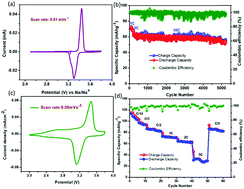
Chem. Commun., 2018,54, 3500-3503
https://doi.org/10.1039/C8CC00365C
Dynamical heterogeneities in ionic liquids as revealed from deuteron NMR
Deuteron NMR spectroscopy is a suitable method to study dynamical heterogeneities in protic ionic liquids. In the 2H spectra of the protic ionic liquid [TEA][OTf] we observe anisotropic and isotropic signals at the same time.
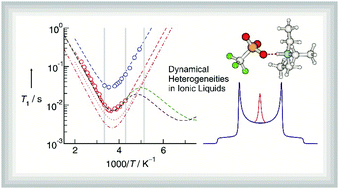
Chem. Commun., 2018,54, 3098-3101
https://doi.org/10.1039/C7CC09440J
Redox fusion of metal particles using deep eutectic solvents
Alternating anodic and cathodic current pulses have been applied to a metal powder on an electrode surface to fuse the particles together. It is shown that homogeneous films can be electroformed with different morphologies depending on the size of the powder and the experimental conditions.

Chem. Commun., 2018,54, 3049-3052
https://doi.org/10.1039/C8CC00360B
New porous monolithic membranes based on supported ionic liquid-like phases for oil/water separation and homogenous catalyst immobilisation
Membranes based on supported ionic liquid-like phase (SIILP) systems with tunable properties allowed oil/water separation and reaction/separation integration in biphasic systems.
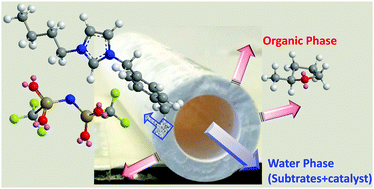
Chem. Commun., 2018,54, 2385-2388
https://doi.org/10.1039/C8CC00371H
Rational selection of the cation of an ionic liquid to control the reaction outcome of a substitution reaction
Rational selection of ionic liquids to get the rate constant you want in a substitution process.
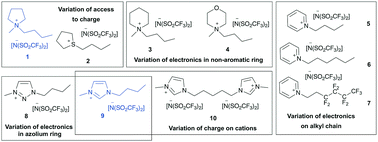
Chem. Commun., 2018,54, 2296-2299
https://doi.org/10.1039/C8CC00241J
High CO2 absorption by diamino protic ionic liquids using azolide anions
Highly efficient low-viscosity protic ionic liquids with enhanced CO2 absorption capacities exhibiting more than 20% w/w uptake.
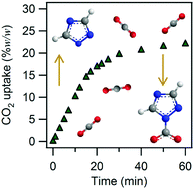
Chem. Commun., 2018,54, 2106-2109
https://doi.org/10.1039/C7CC09331D
About this collection
This web themed issue highlights the breadth of ongoing research into the discovery and application of ionic liquids for use as materials and devices. Contributions cover all aspects of ionic liquid chemistry and illustrate the methods that can be used to develop materials and devices to be applied in fields ranging from catalytic processes to electrochemistry.
The collection is guest edited by Robin D. Rogers (University of Alabama) and Douglas MacFarlene (Monash University).
Articles in this web themed issue will be added below as soon as possible after they are published. Please return to this page frequently to see the collection grow.